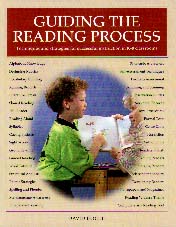|
________________
CM . . . .
Volume VI Number 2 . . . . September 17, 1999
excerpt: Effective school change in the teaching of reading occurs from the inside out, with a staff who understands the foundations of the reading process, and who incorporates techniques and strategies that will enable each child to achieve reading success.Who wouldn't welcome a new book by one of Canada's foremost reading educators, University of Toronto's David Booth? Guiding the Reading Process arose, as we are told in the "Introduction," from Booth's delivery of an in-service course to teachers who needed both a theoretical/philosophical background on reading and classroom ready ideas and materials. As a university instructor who frequently works with teachers "in the trenches", I recognize Booth's challenge and applaud his response in Guiding the Reading Process. His book is filled with the highlights of a good basic "Reading in the Elementary School" course: a survey of the latest theory and thought followed by ideas on how these ideas are enacted in the classroom (and all for a very modest price!). Booth's book has, therefore, two parts: a slim theory section of 19 pages entitled "Becoming a Reader," followed by 87 pages of "Techniques and Strategies," and another 30 pages of appendices. The theory section includes topics such as "How do we learn to read?" and "The importance of response to text." Booth has written Part I with an audience of busy practitioners firmly in mind. All ideas are highly summarized, with nary a citation or mention of a theorist anywhere. Although I, too, have encountered resistance to theory from practicing teachers, I wonder if the answer is to cleanse our workshops of any mention of the sources of our ideas. Many teachers want to consider the foundational ideas. Part II: "Techniques and Strategies" contains a fairly typical summary of the current approaches to teaching reading such as "Conducting a Running Record," "Establishing a Literature Circle," and "Choral Reading." There does not seem to be any organization to the order of the topics, and an introduction to this section might have pointed out whether any order was intended. At the back of the book, however, there is an index for readers looking for a specific topic. Appendices include black line masters on topics such as "A Teacher's Checklist for Guided Reading" and "A Plot Organizer." For some reason, not disclosed in the introduction or anywhere else I could see, the entire book is also numbered by subheading (I speculate that this may be for use of in-service participants, that is "Today we will begin by talking about topic 51. 'Genre Studies '"). Even the bibliographies are numbered (e.g. 70. "Books for Independent Readers"). I found this numbering system distracting, but this is a minor quibble since all of the topics in Guiding the Reading Process are ones likely to be useful for teachers of reading. For teachers interested in broadening their base of reading strategies and approaches, there are other sources which may prove just as useful or more useful. For example, Manitoba Education and Training has published Foundation for Implementation documents with activities and accompanying assessment for each of the specific outcomes in the English Language Arts curriculum. Ontario teachers might be interested in Teaching Children to Read & Write by the Toronto District School Board (Scarborough). These materials are directly connected with curriculums in their respective provinces. Recommended with Reservations. Deborah L. Begoray is an associate professor in Reading/Language Arts in the Faculty of Education at the University of Manitoba. She is currently assisting pre-service and in-service teachers to implement the Manitoba English Language Arts Curriculum (1996).
To comment on this
title or this review, send mail to cm@umanitoba.ca.
Copyright © the Manitoba Library Association.
Reproduction for personal use is permitted only if this copyright notice
is maintained. Any other reproduction is prohibited without
permission.
Published by
TABLE OF CONTENTS FOR THIS ISSUE - MARCH 12,
1999.
AUTHORS |
TITLES |
MEDIA REVIEWS |
PROFILES |
BACK ISSUES |
SEARCH |
CMARCHIVE |
HOME
|

